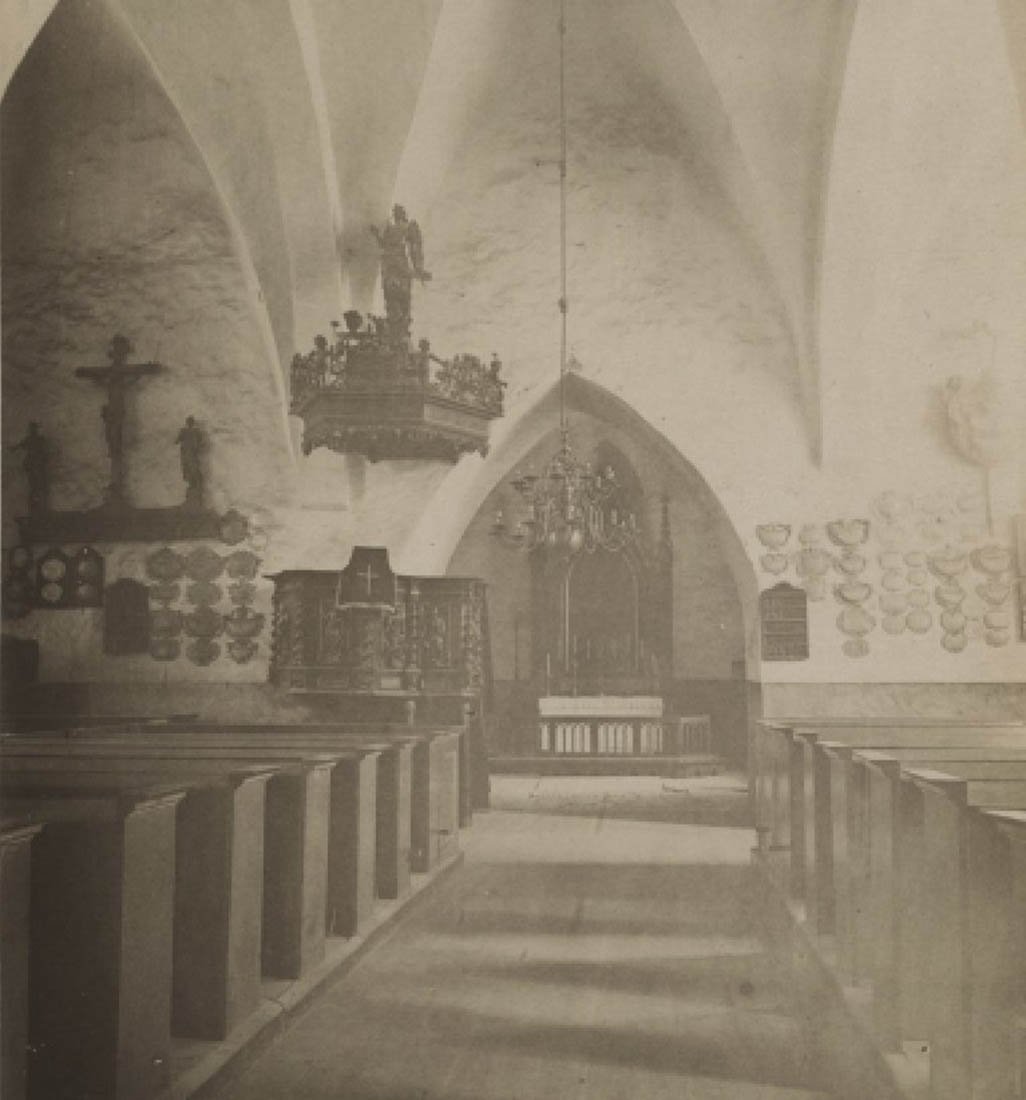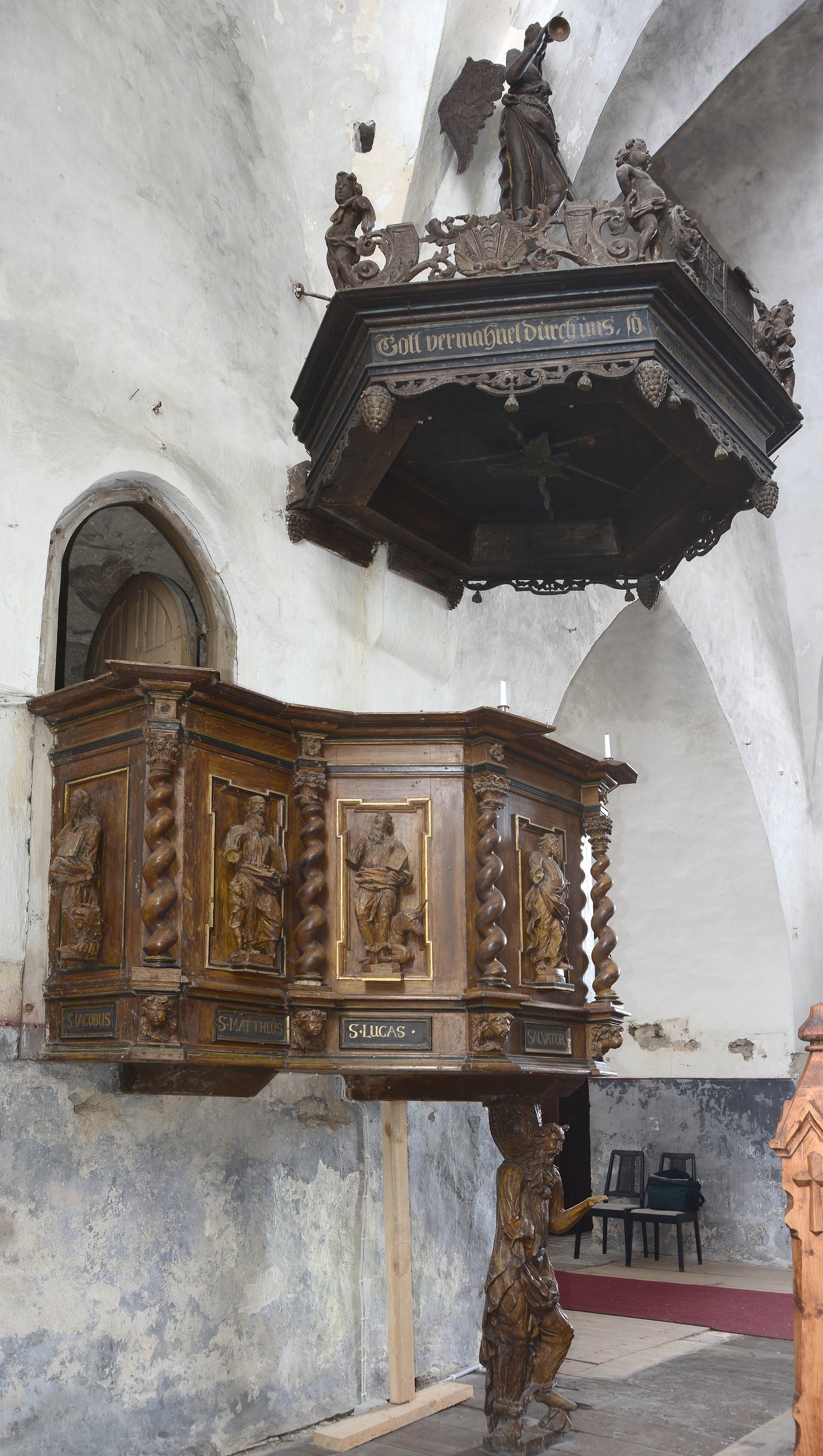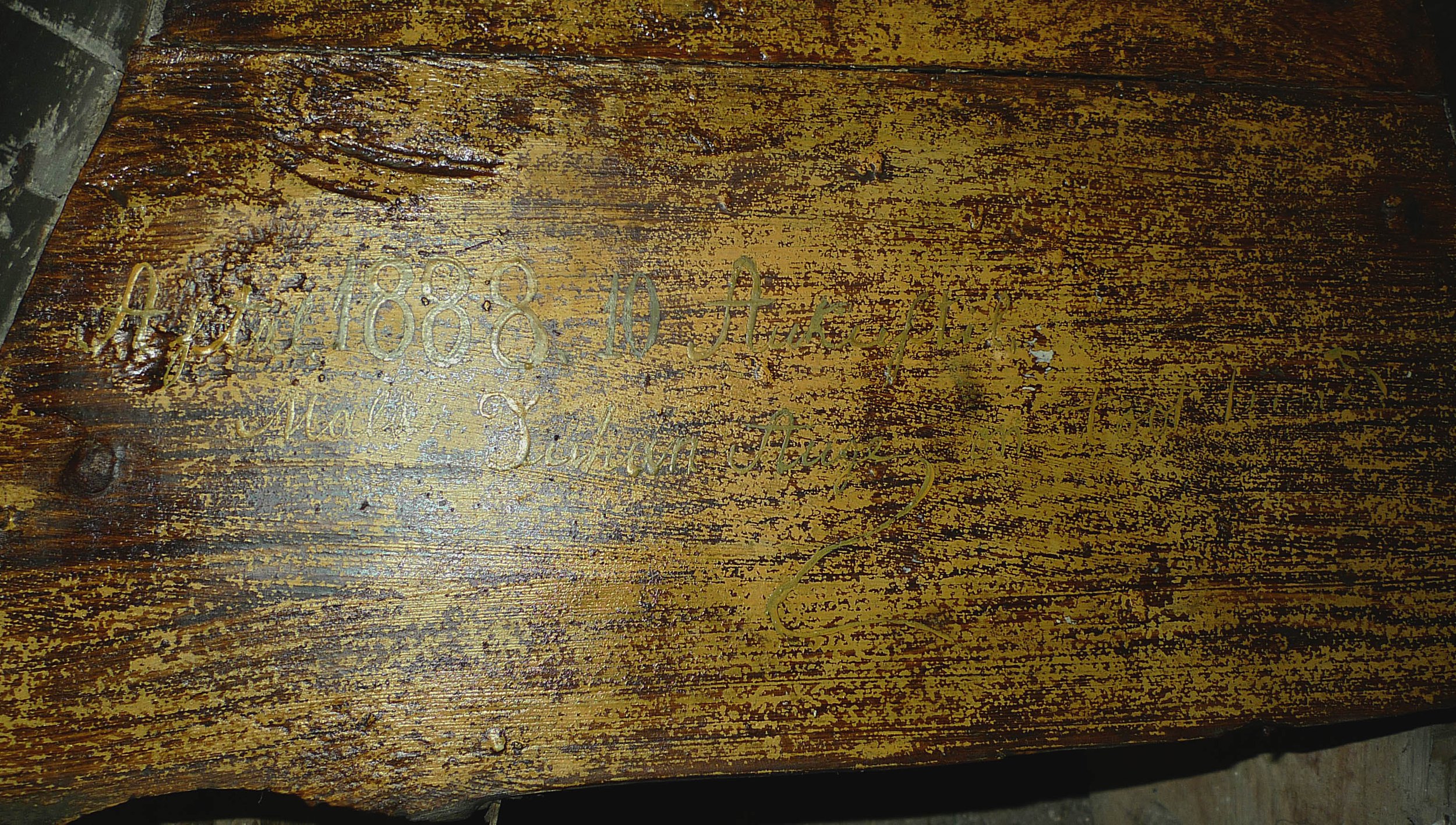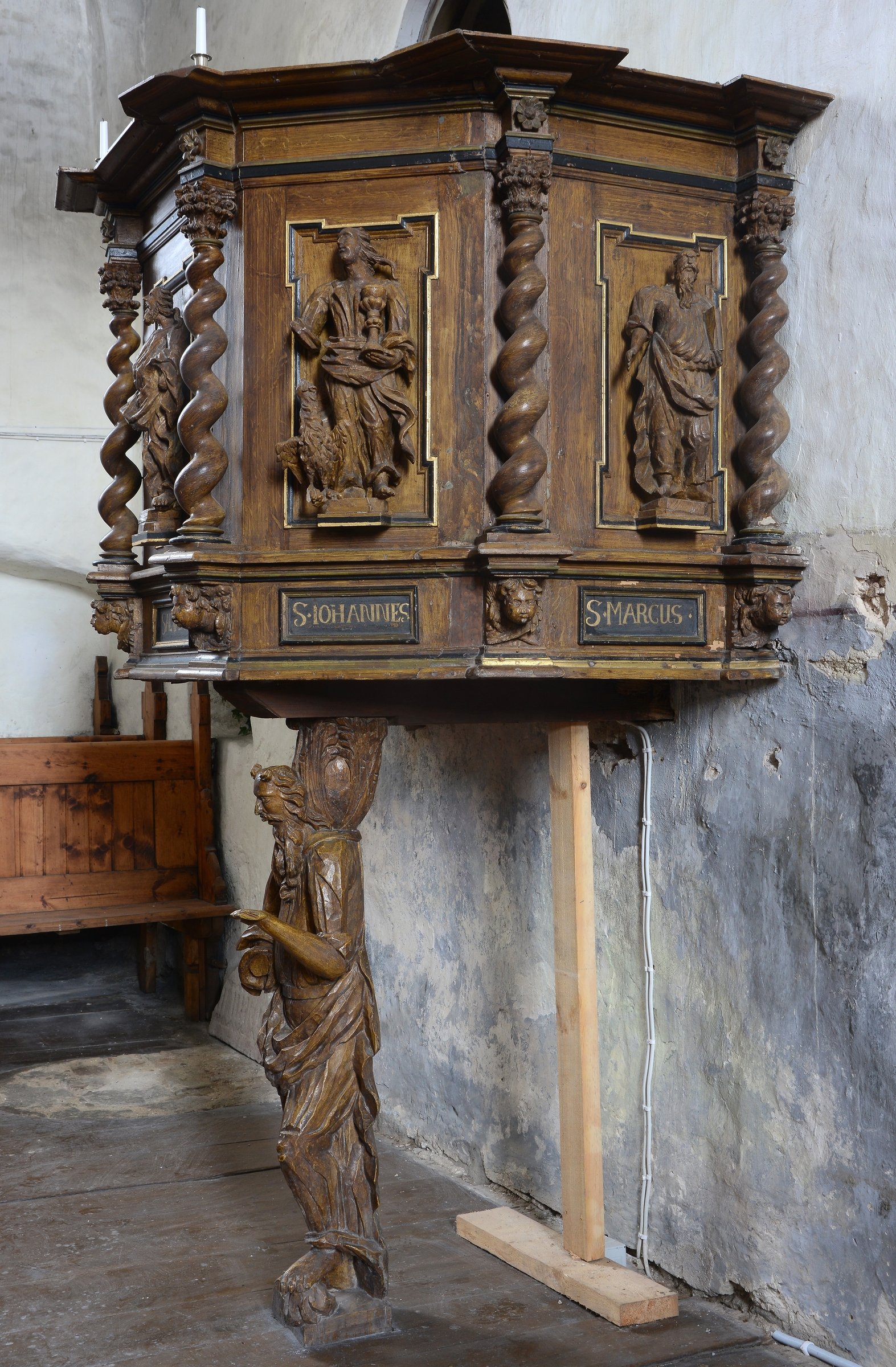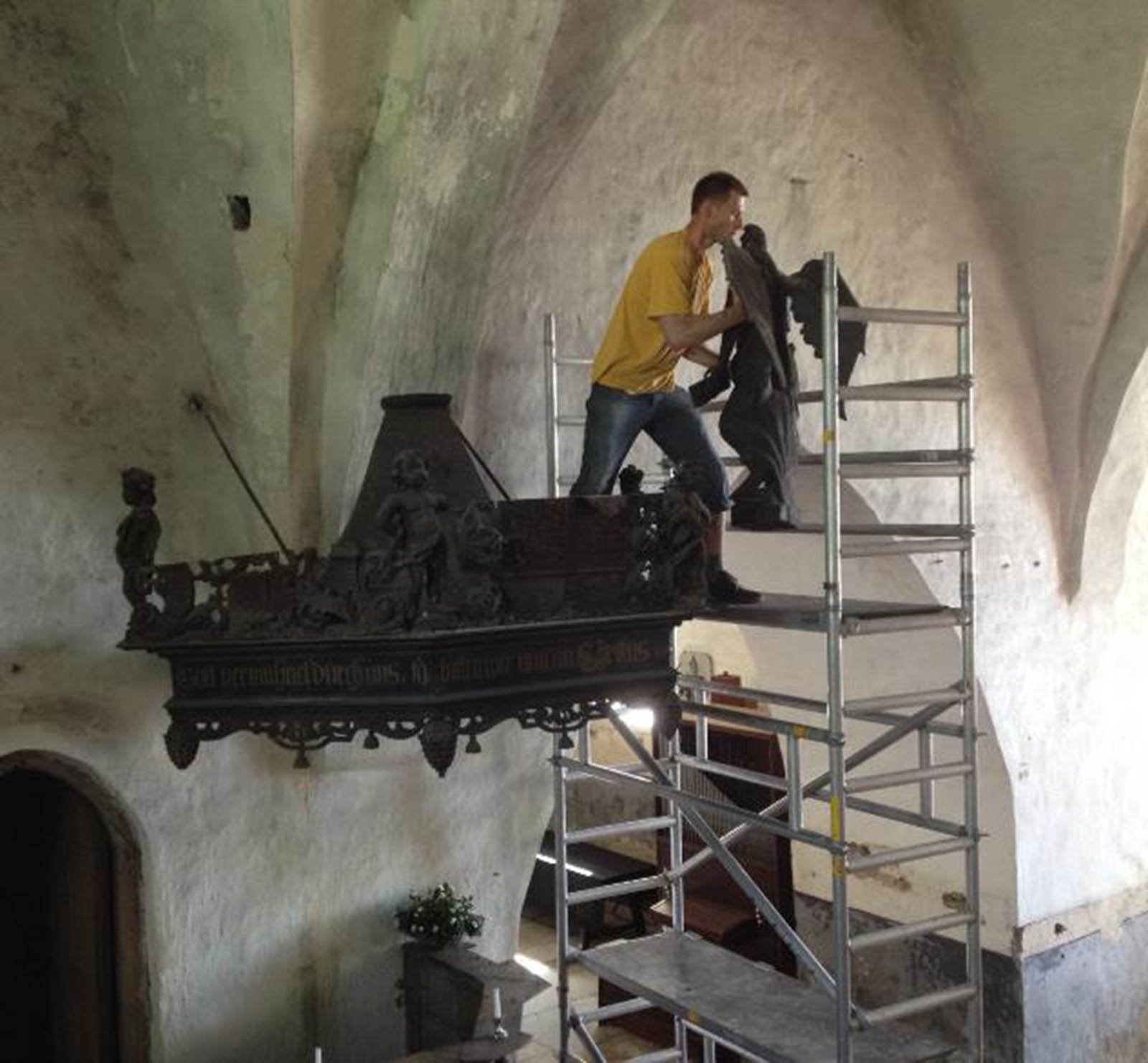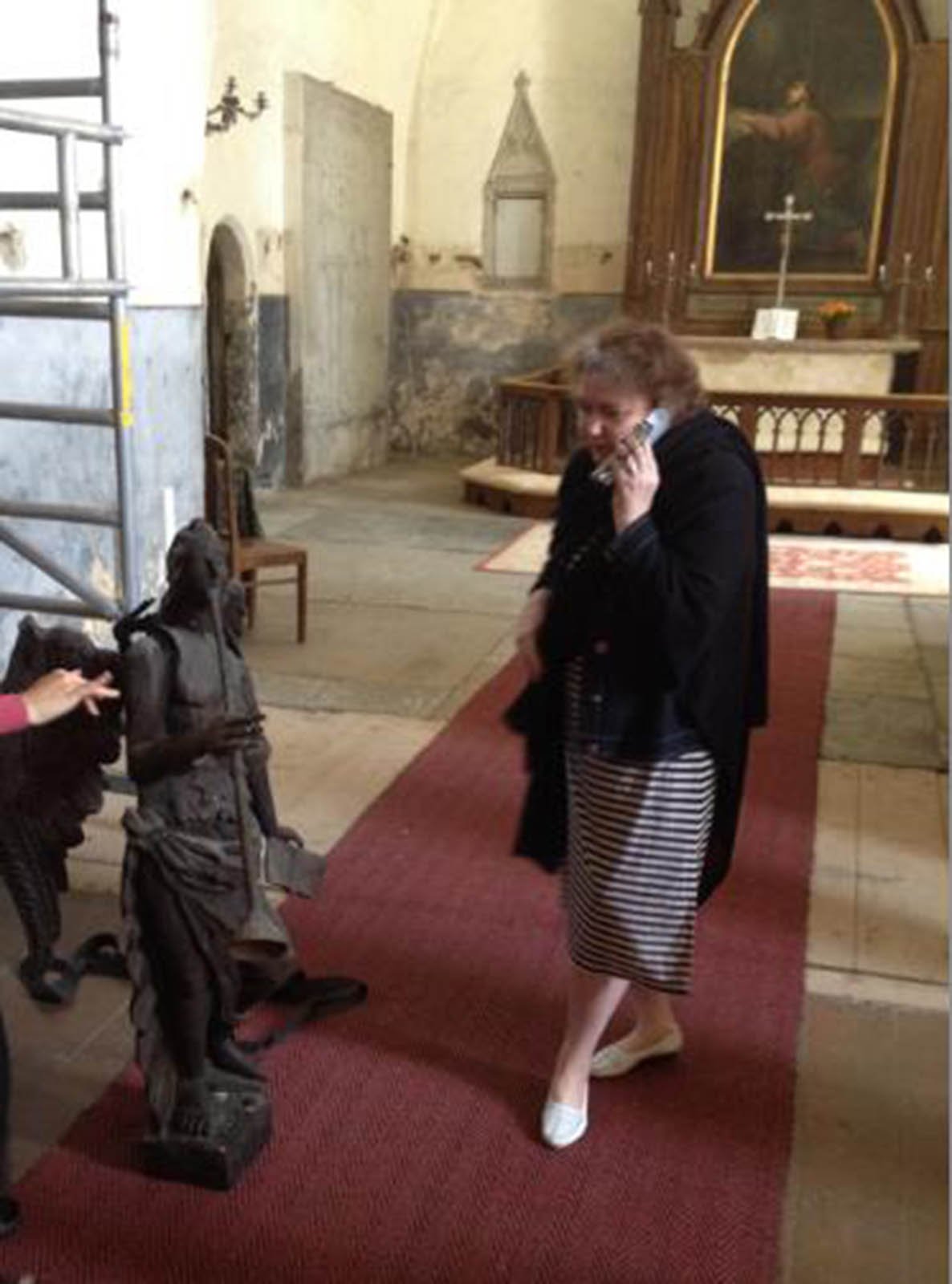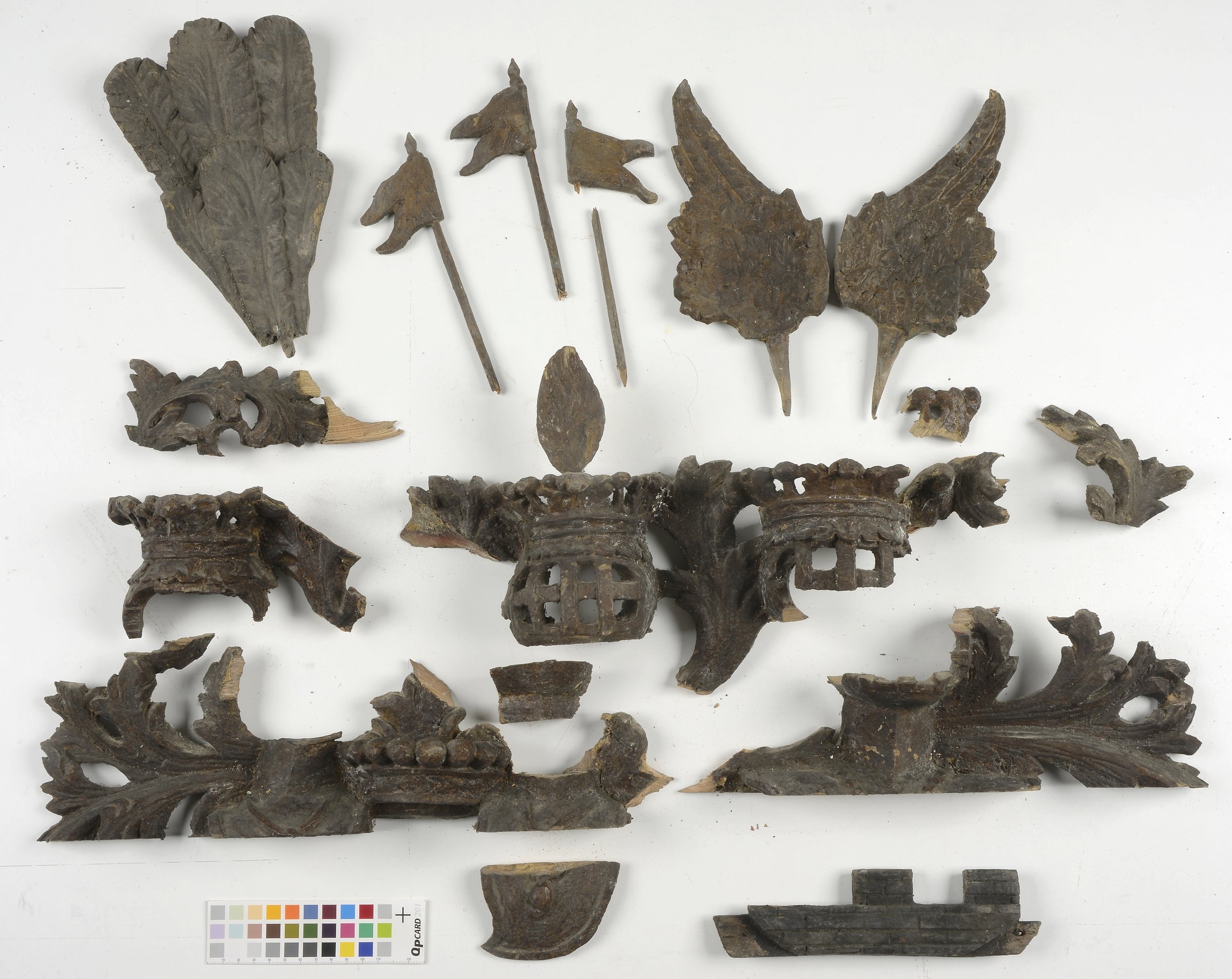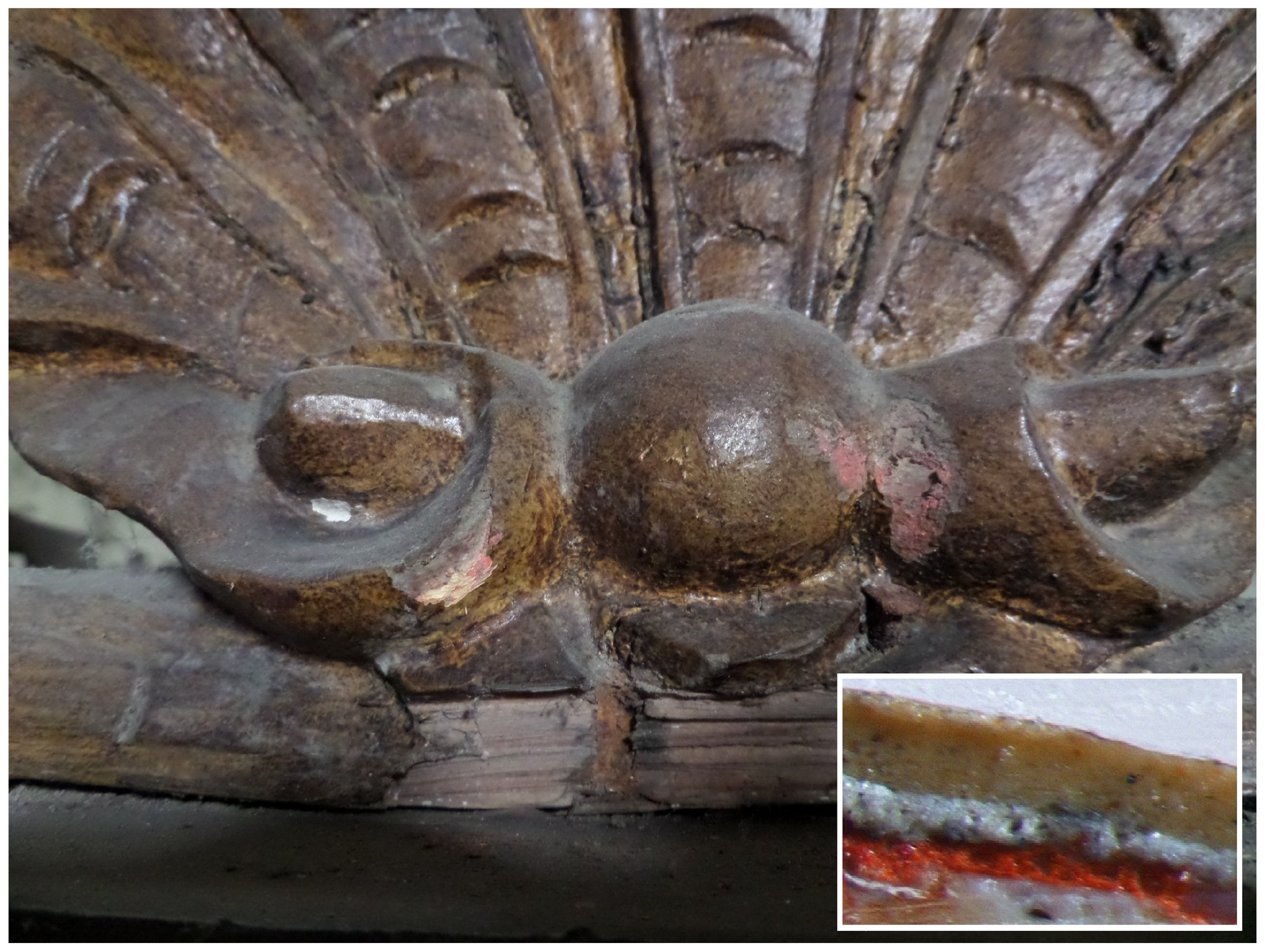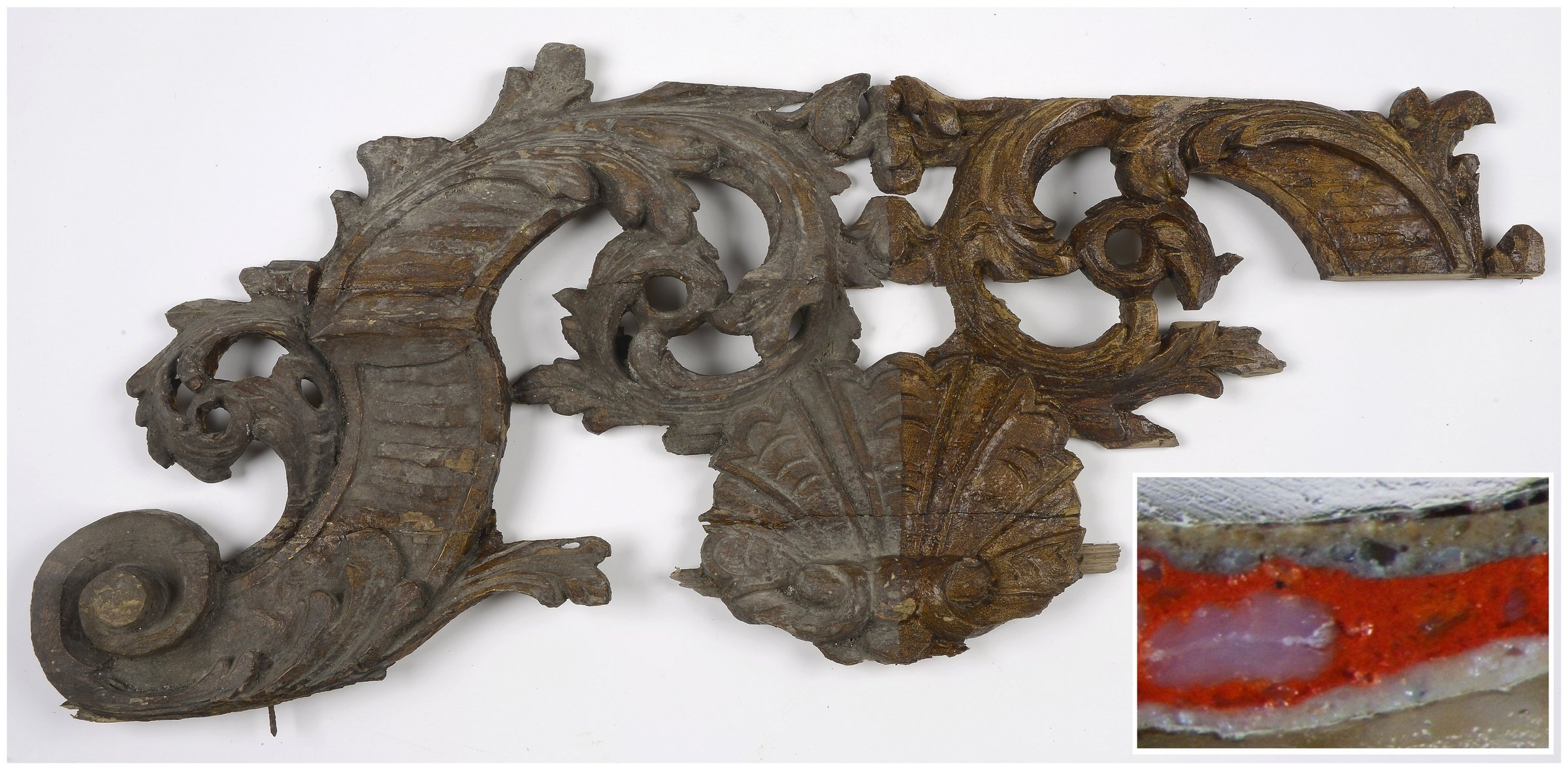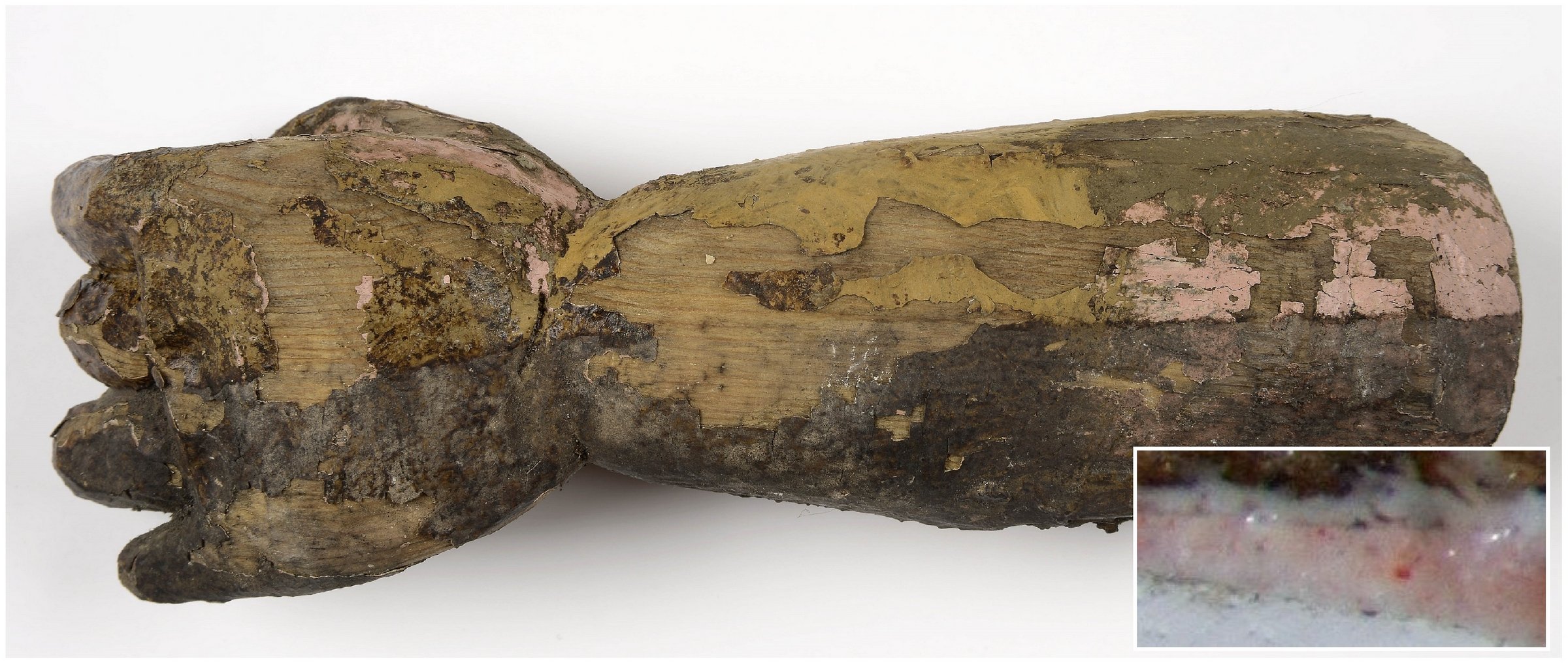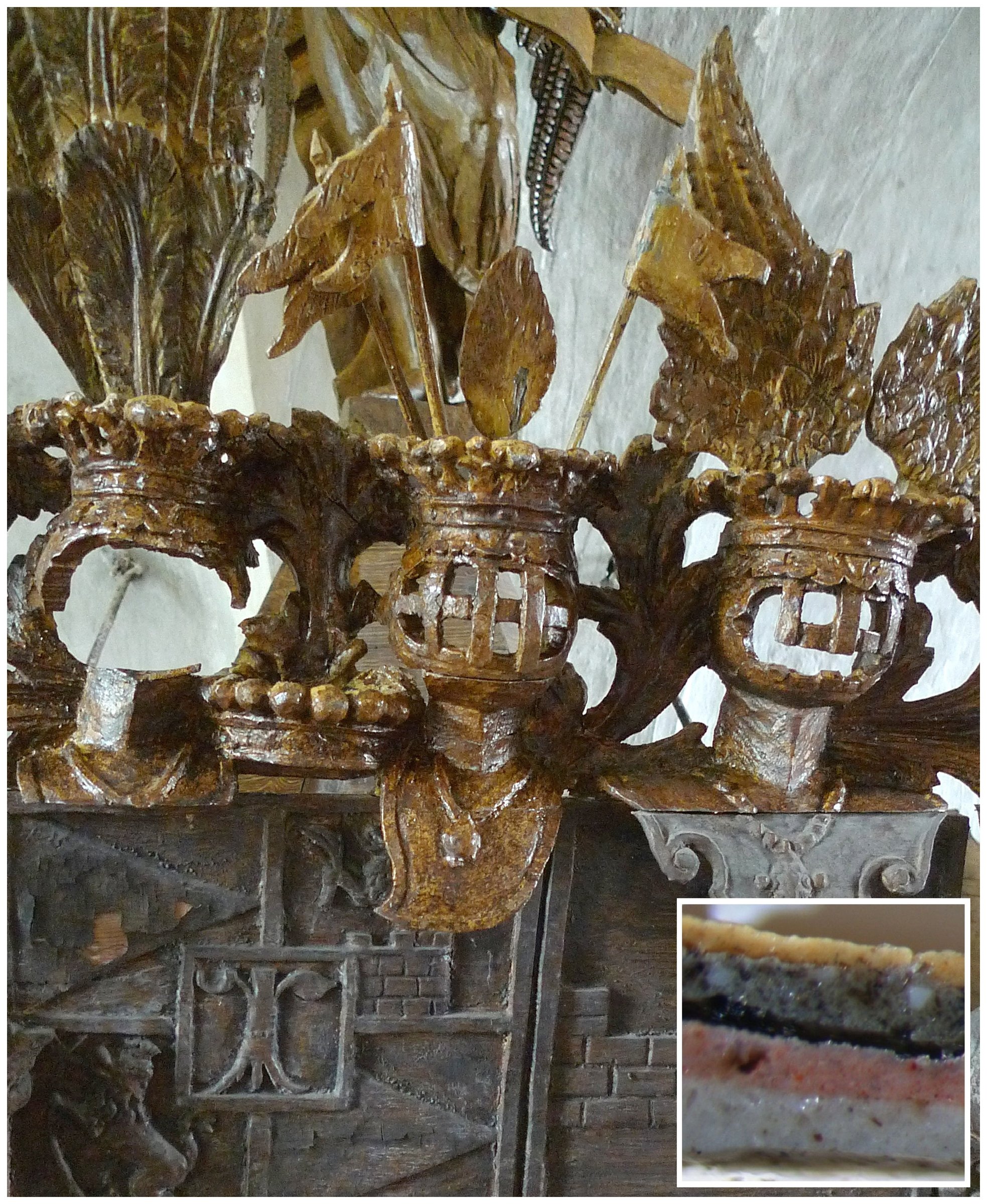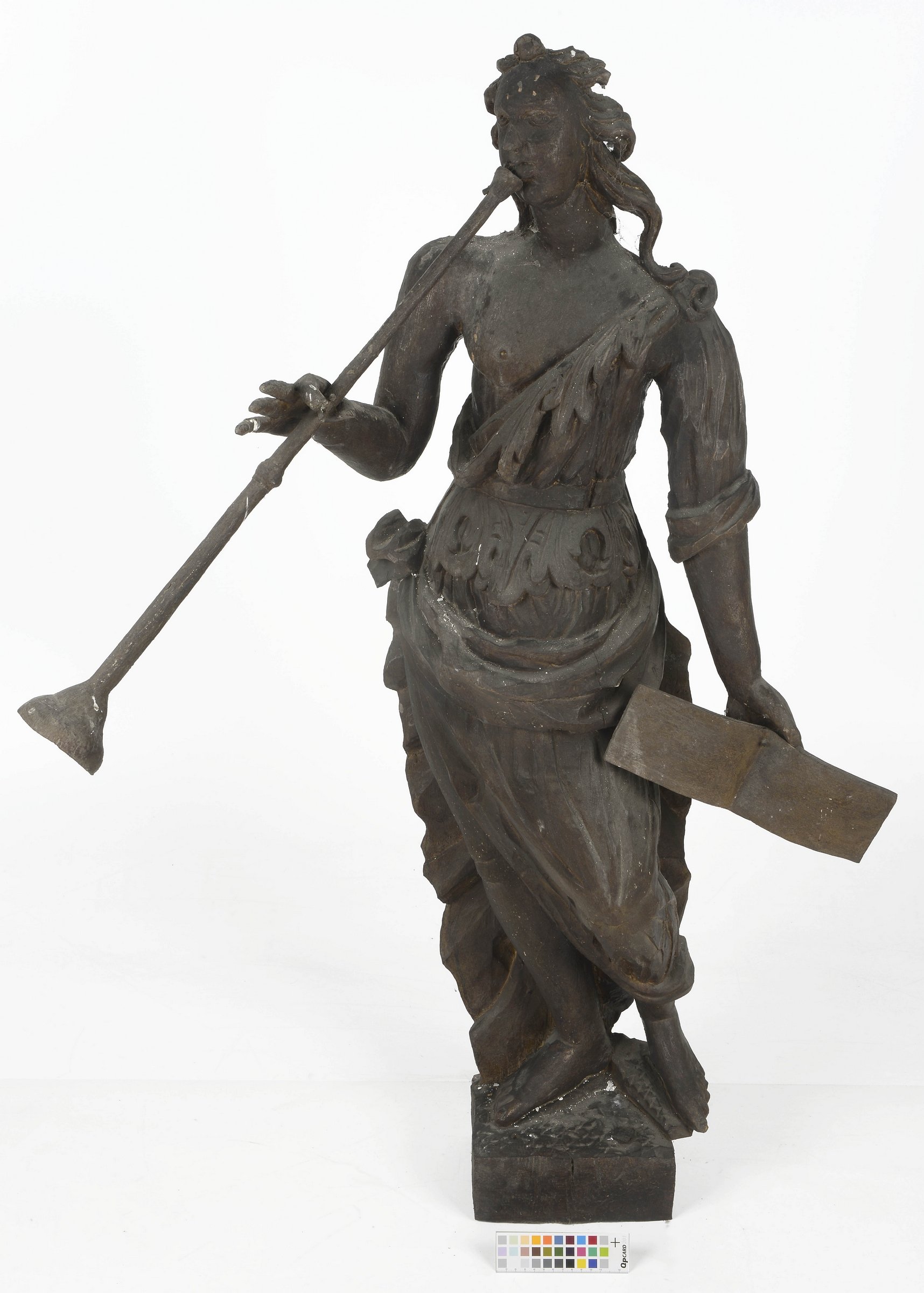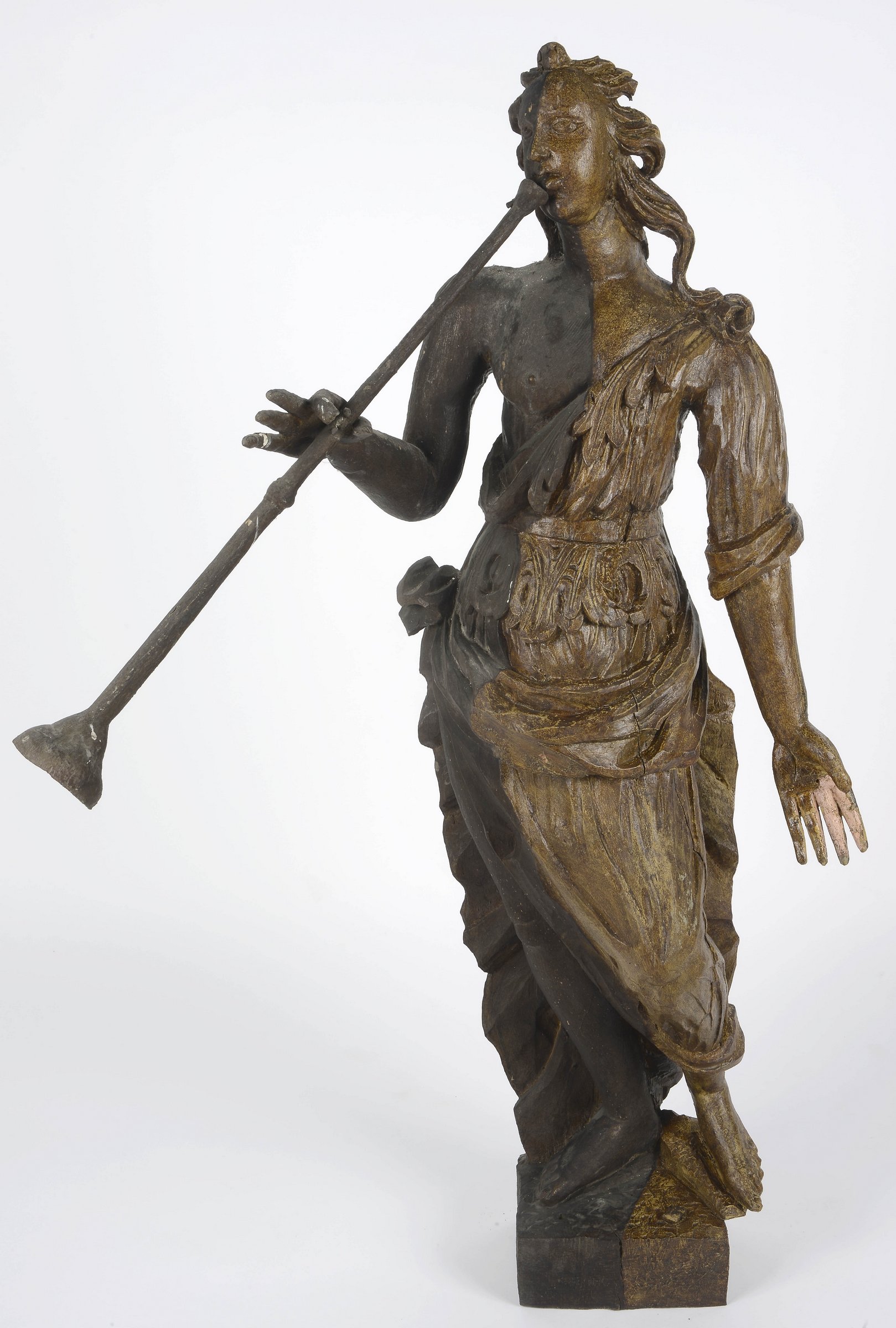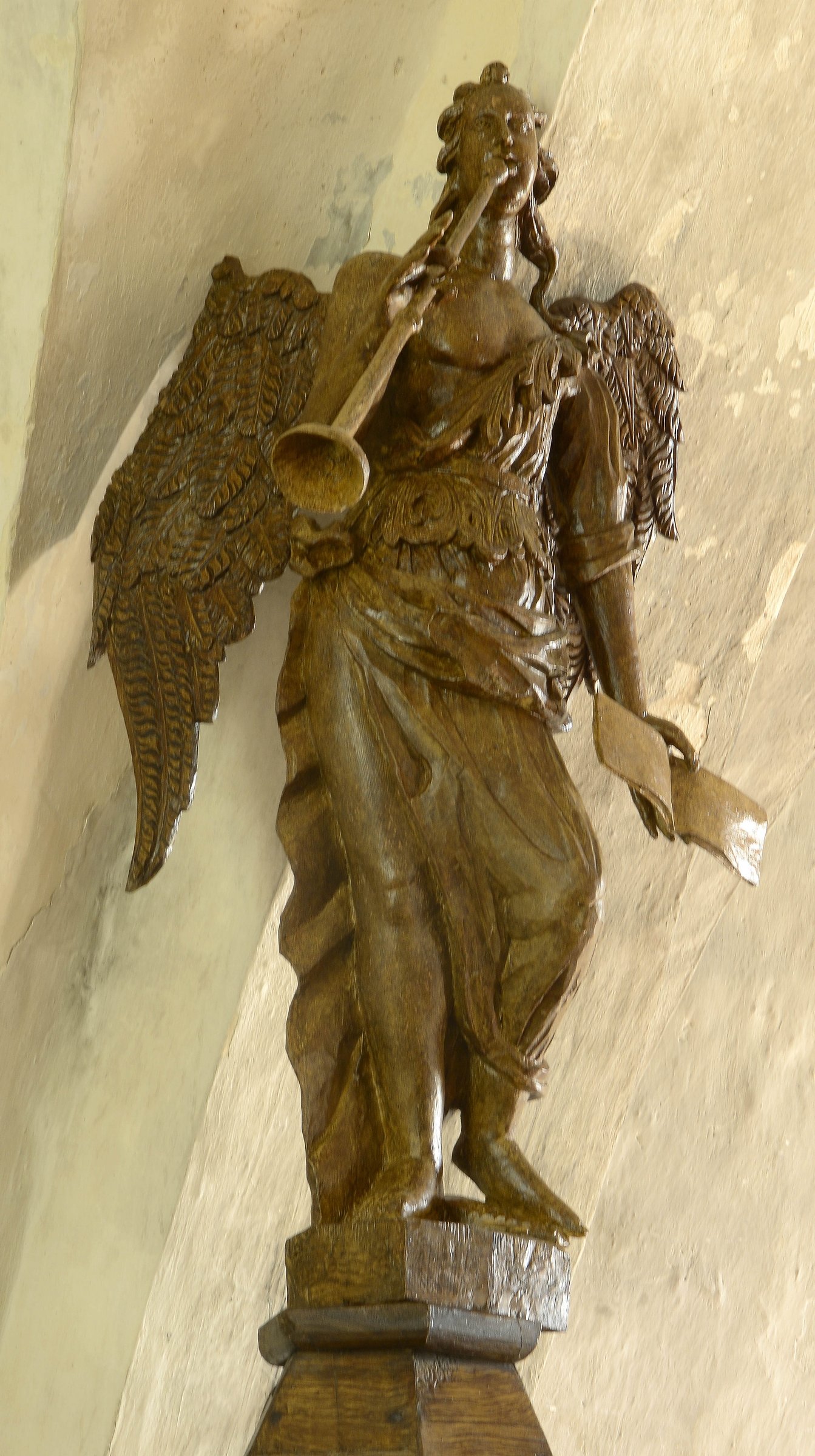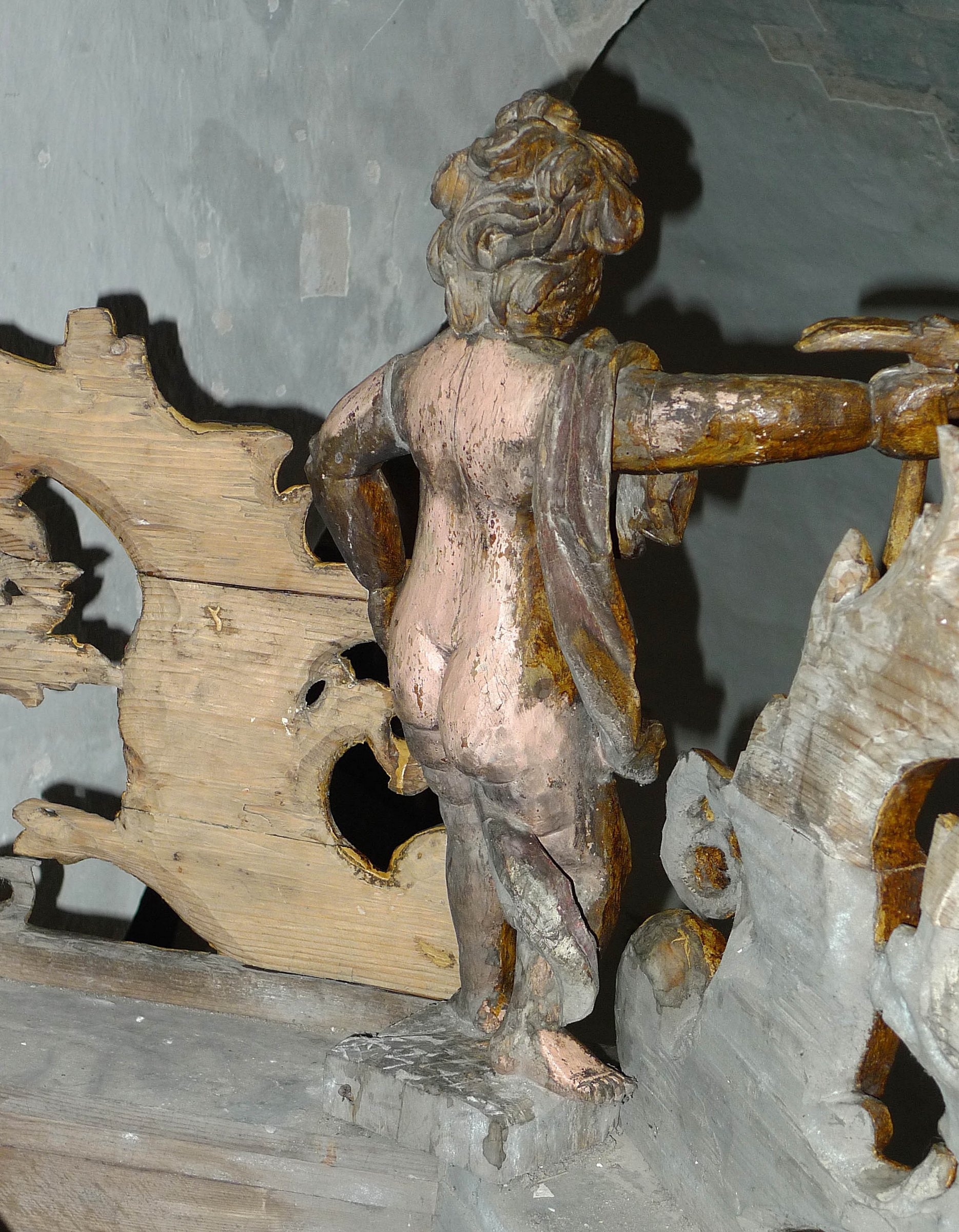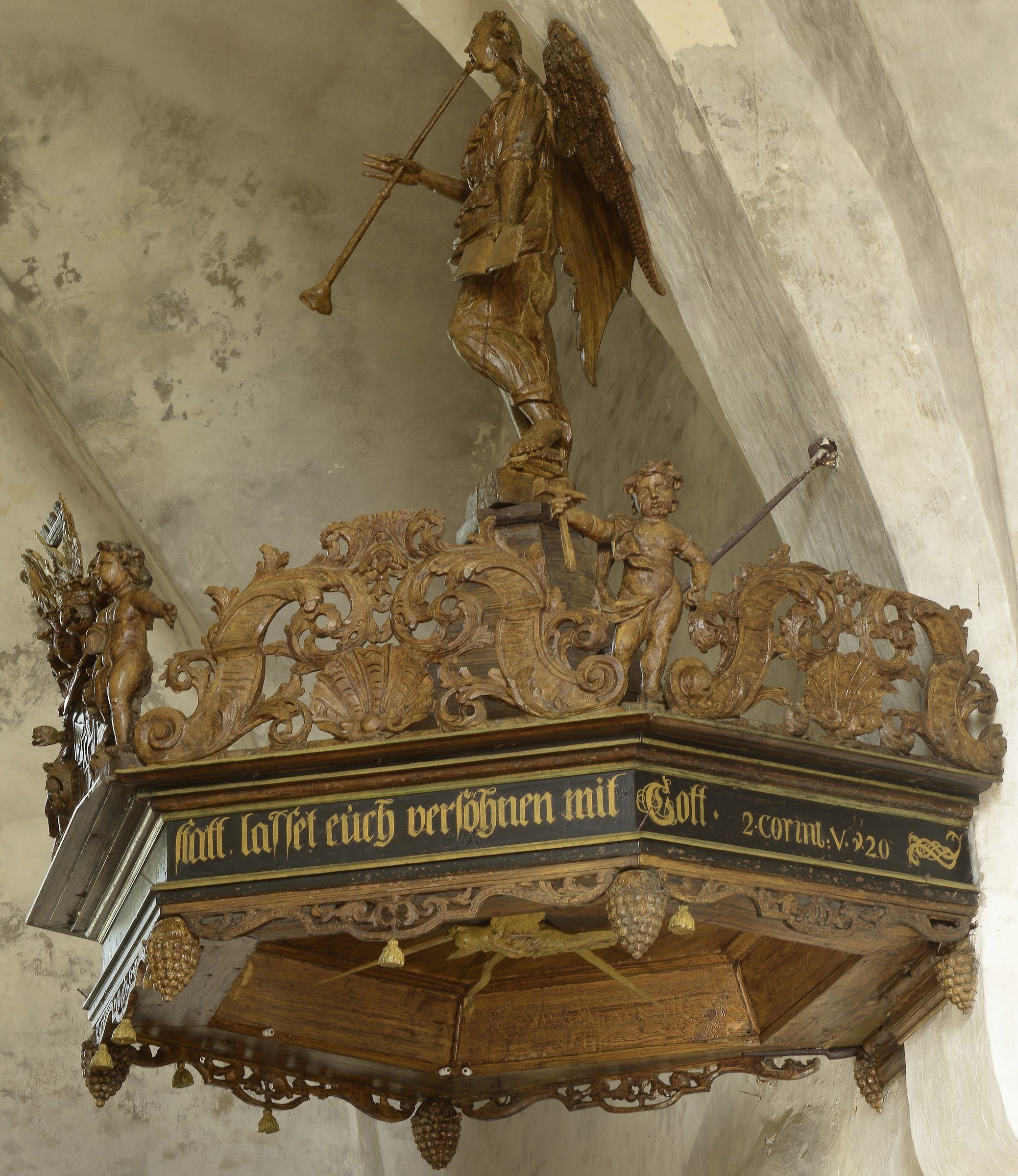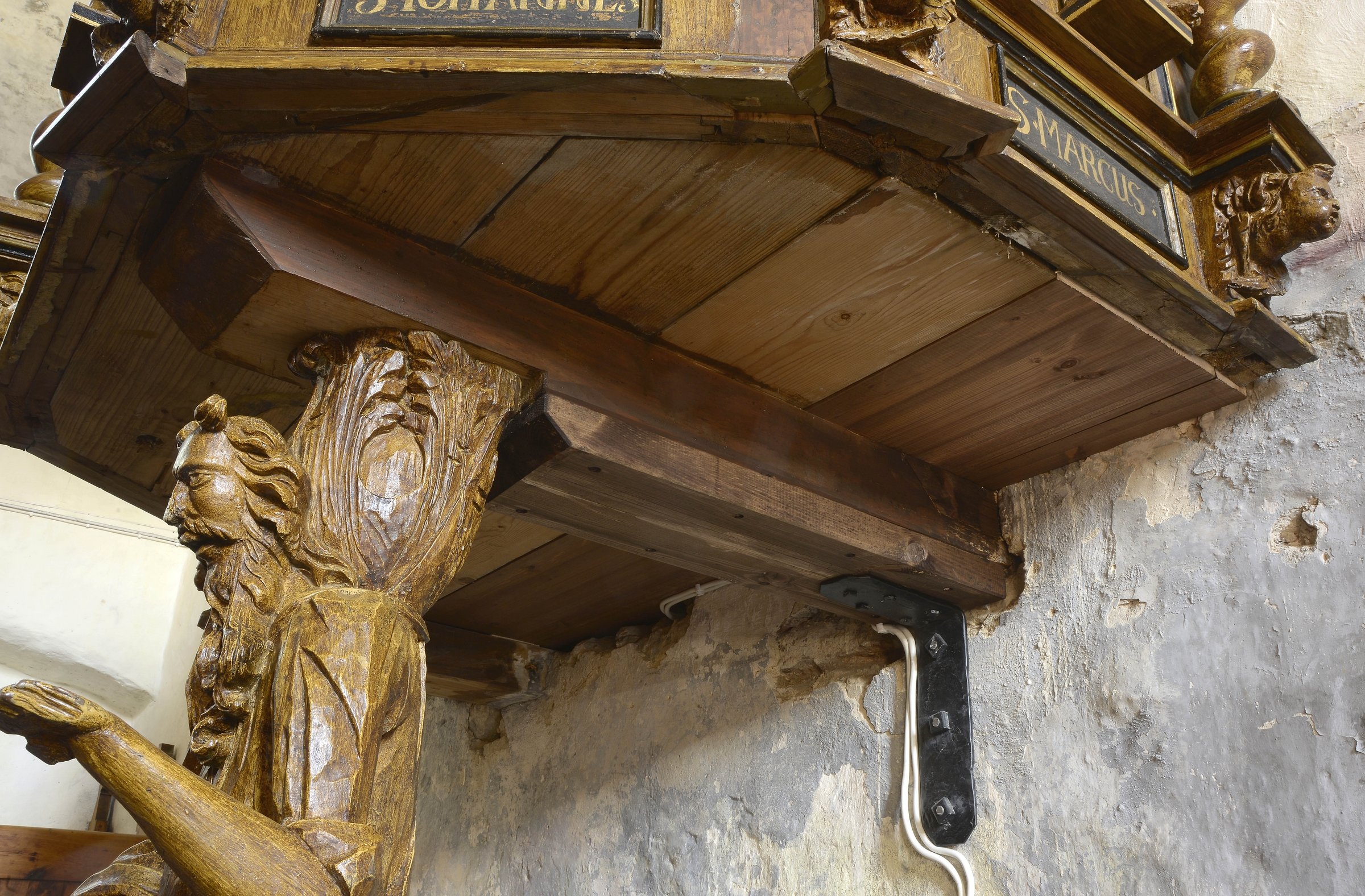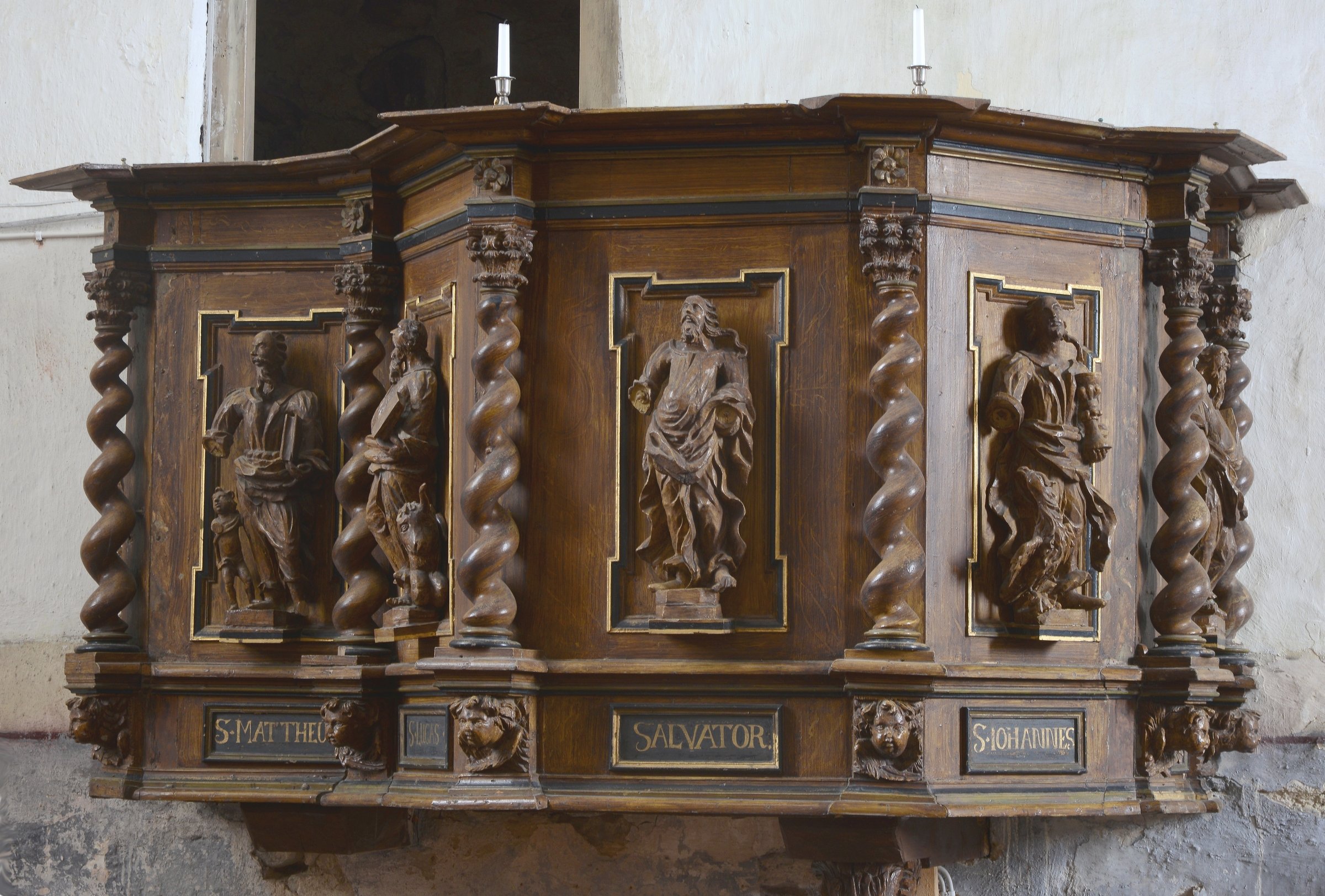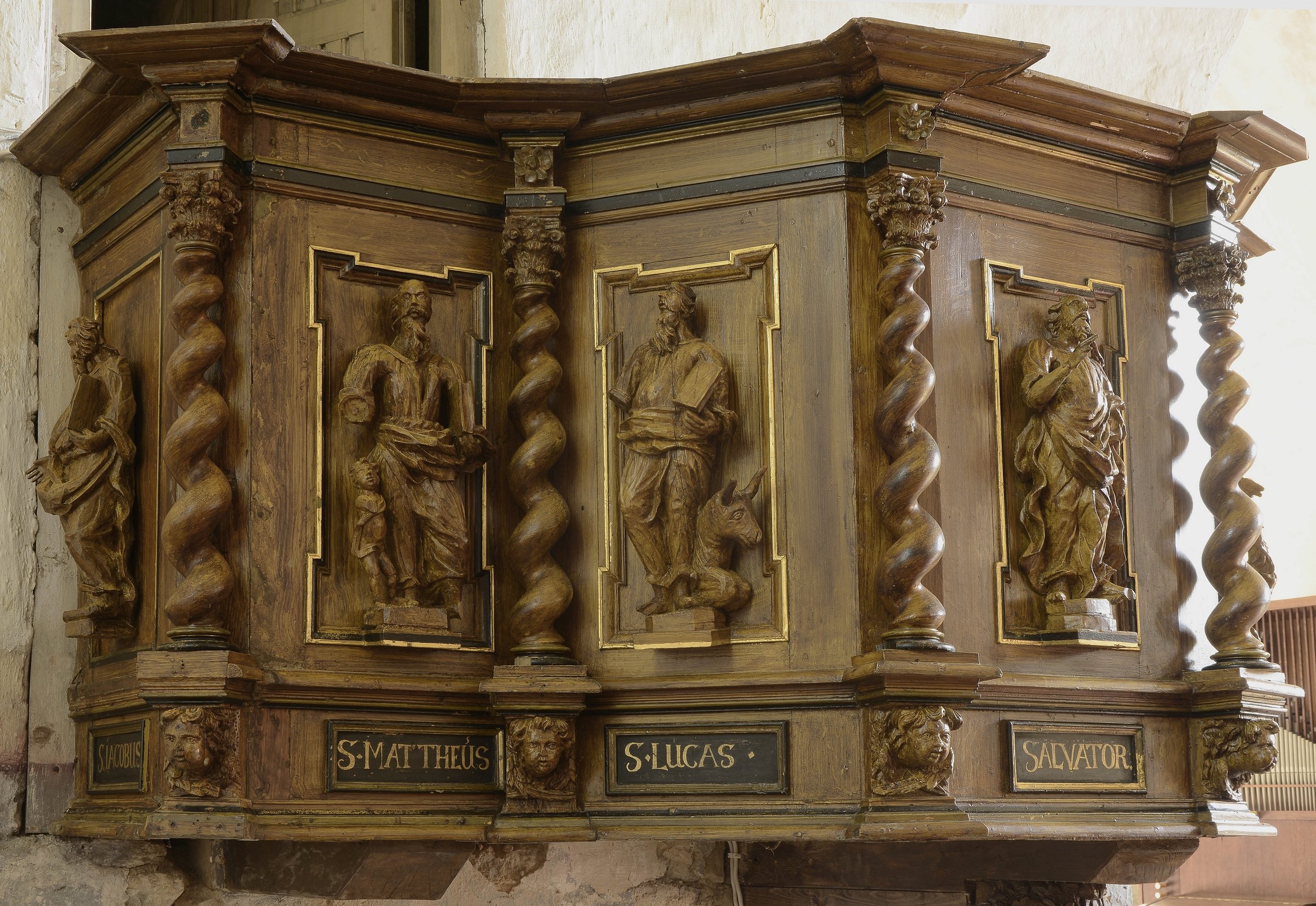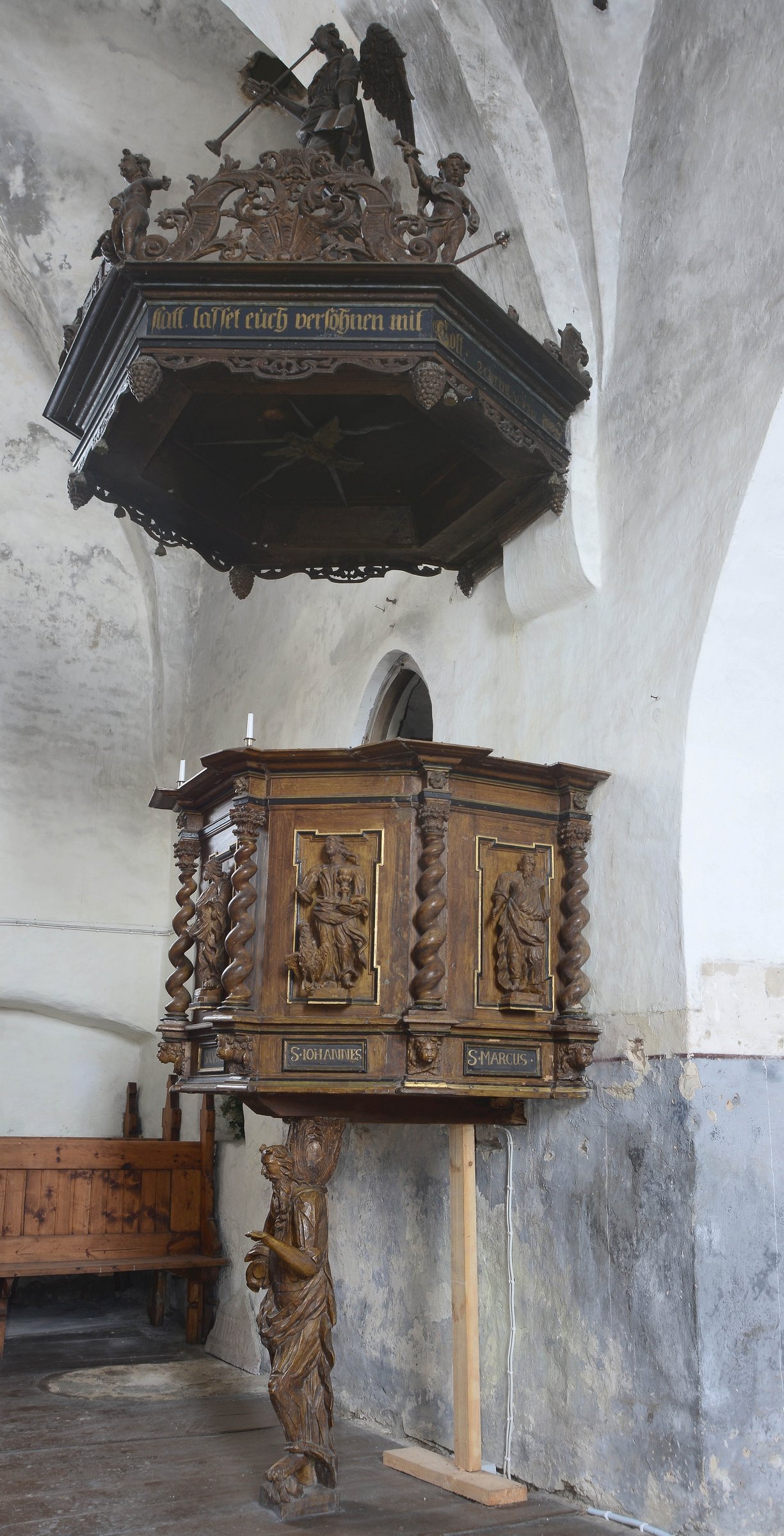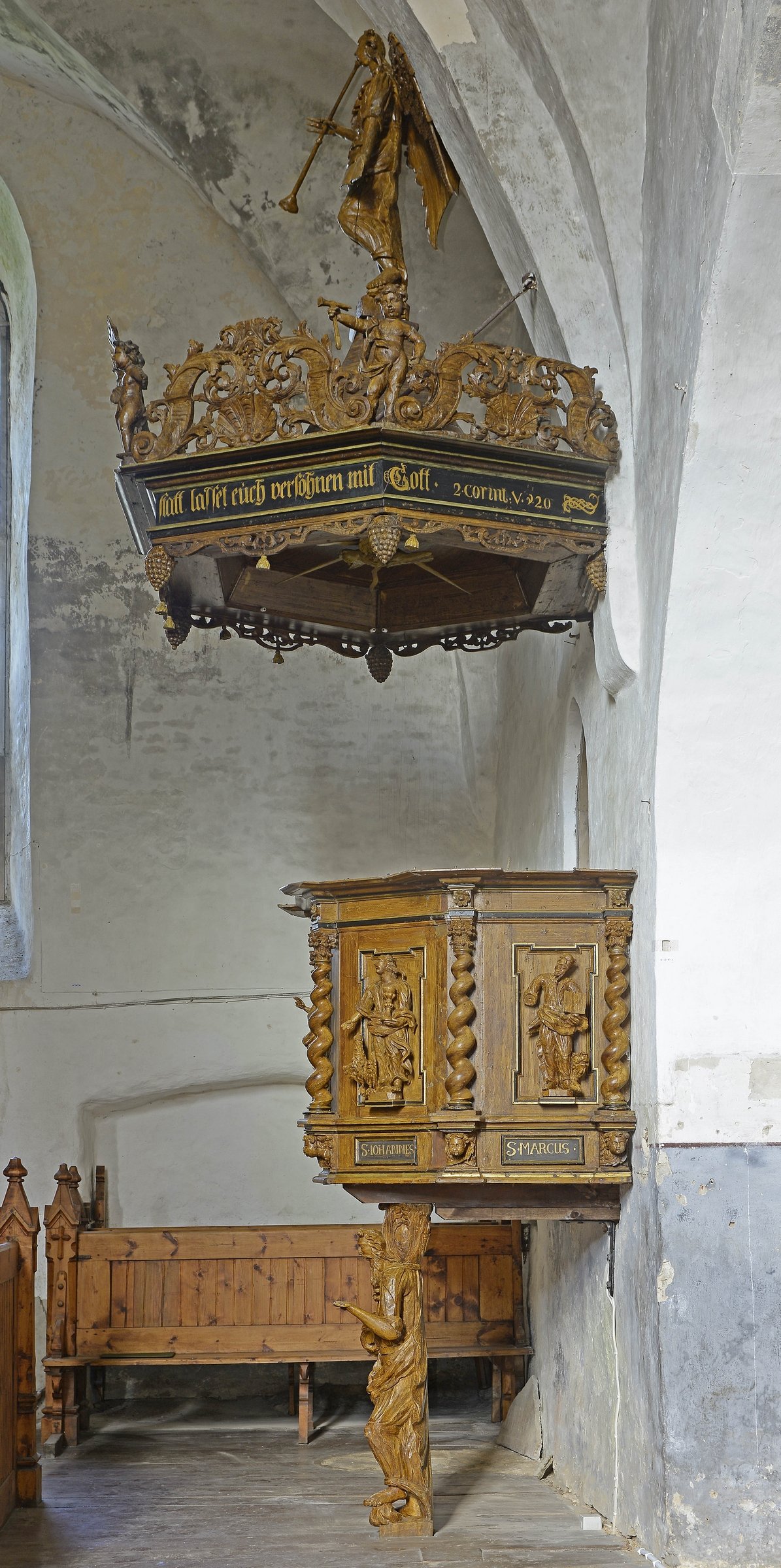STORY OF THE PULPIT IN THE HALJALA ST MAURICE’S CHURCH
Autor:
Ingrid Pihelgas, Maria Lillepruun, Viljar Vissel
Year:
Anno 2015
Category:
Conservation
The pulpit in the Haljala Church made by the 18th-century master Johann Valentin Rabe and dated to 1730 was accounted as a relic under preservation already in 1973. J. V. Rabe was a woodcarver from Lübeck who arrived in Tallinn in 1718 and whose work can be found in several Estonian churches. In addition to the above-mentioned Haljala pulpit, the altar of the Rakvere Church and the pulpit of the Jõhvi Church (1728) are also accounted as national relics under protection.
DESCRIPTION OF THE PULPIT
A photo in the Estonian History Museum’s collection shows where the pulpit and its steps had once been. The whole interior of the church was changed on the initiative of the head of the Estonian Knighthood and landlord of Aaspere manorial estate, Eduard von Dellingshausen in 1896-1898. The church was given new neo-gothic pews (designed by R. von Engelhardt) and galleries. The pulpit was removed from its earlier location and placed to make it possible for pastors to mount the steps through a neo-gothic panelled door from the vestry. Due to the change in the location the angel, trumpeting on the canopy (soundboard) lost a part of his left wing – otherwise the figure would not have fitted under the arch.
Johann Valentin Rabe carved figures of Christ and the four evangelists with their attributes on the panels of the baroque pulpit and provided them with names S. MATTHEUS, S. LUCAS, SALVATOR, S. JOHANNES, S. MARCUS. Twisted pillars separate the panels from each other. The pulpit is supported by a full plastic figure of Moses. The canopy has been decorated with exuberant baroque acanthus ornament and plastic putti, the donators’ coats of arms decorate the front. Archangel Michael’s trumpet-blowing figure towers above all. The text ‘Gott vermahnet durch uns, so bitten wir nun an Christus’ is inscribed on the side of the canopy.
The pulpit is made of coniferous wood but its carved details are of deciduous wood. The initially polychrome pulpit has been repainted for several times. The last solution – the surface grain that imitates oak-wood – dates from the late 19th century. The text that dates the grain to 1888 and gives the name of the master as ‘painter Juhan Auge’ can be found on the left side of the throne under Archangel Michael’s figure.
CONDITION OF THE PULPIT
The fire in the summer of 1998 damaged the whole interior of the church. The pulpit, altar wall and galleries were all covered with a layer of soot. The wood of the pulpit was in a satisfactory condition but its wall-side groundsel and floorboards as well as a part of details had serious moisture damages.
By 2014 the pulpit was in such a bad condition that it prevented the pastor from committing the pulpit service.
All the loose details and the figure of Archangel Michael were brought to the conservation centre Kanut to check the paint layers and conserve the details in workshop conditions. As the moisture percent in the workrooms of the centre is only 42, we had to create conditions that would be close to those in the church interior (70-80 %). For that purpose a (climatic) chamber was prepared, where the necessary moisture level was achieved with the frame of wooden slats and plastic film. Wet silica gel granules in Petri dishes granted the necessary moisture level (65-70%). The readings were checked with the help of moisture indicators.
The repairs of wood within the church premises were carried out in September 2014.
RESEARCH AND ANALYSIS
Technological research of the paint layers was carried out in the church and also in the workshop. The priming was thin and not even visible to the bare eye but could be detected on the micro-cuts. White priming was found only on carved details that had once been gilded or silvered (e.g. the crests and crowns decorating the coats of arms). Traces of gilding and silvering were visible on micro-cuts and also when the grained details were carefully observed. Some ochre-like pigments that had been used at marbling were also found. Gold leaf had been used on the nameplates of the saints but later re-freshening processes had been done with gold and bronze paints.
Our research proved that the initial polychrome had been repainted two or three times. Bright colours were covered with a monochrome grey layer and sometimes this grey had two shades. The grey layers were repainted once more in brownish tones to imitate the oak-wood grain. Both, visual observations and crosscuts from smooth surfaces showed a layer of top cover.
CONSERVATION OF THE PULPIT
Testing the possible soot removing and cleaning solutions was initially carried out on various details of the pulpit in the church already. For removing soot the 2.5-5 % Tri-ammonia-citrate solution with added acetone for greater cleansing effect was considered to be most suitable. Wet cleaning of the surfaces was done together with fixing the ground and paint layer with 25% Acronal 500D solution. For protection of the conserved surface lacquer Lefranc & Bourgeois diluted in white spirits. In addition to the loose details, the painted surface treatment was carried out in the church as well.
As for the construction of the pulpit, its floor together with the groundsel needed repairs. The upper rotten part of the groundsel was chiselled out and replaced with spruce wood. The groundsel was supported from below with a board and a new forged set square that was anchored to the wall. The figures of Saint Marcus and James were relocated onto their original places. The figures of Christ (Salvator) and John and the putto supporting the left-side acanthus leaf of the epitaph coat of arms got their missing hands back. All the repairs on and of wood were achieved with wood dowels and cold glue Titebond. The forged supports and nails of the soundboard and the later nails used to fix ornaments were all treated with rust repellents.
Only the pulpit structure and canopy were restored in the church but the whole fire-damaged interior needs more to be done to it. The soot-covered vaulted ceiling with its peeling and dripping paint is a danger to the recently cleaned pulpit and especially to the soundboard, the canopy of which catches whatever comes from above.
Conservators – Maria Lillepruun (research, methods, polychrome), Ingrid Pihelgas, Marika Mängel, Üüve Vahur (polychrome), Viljar Talimaa, Mart Verevmägi (constructions).
MATERIALS:
Värviproovidest ristlõike lihvide valmistamine: valguskõvenev vaik Technovit 2000LC (Heraeus Kutzer GmbH technik.wehrheim@heraeus.com); fotografeerimine stereomikroskoobiga Examet Union, suurendustel 50–250 x
Acronal 500D (www.kremer-pigmente.de)
Triammooniumtsitraat – kelaatija, 5% -lise lahuse pH 6,0–7,0 (OÜ Kemasol, Tallinn)
Läiklakk „Lefranc & Bourgeois“ (extra-fine picture varnish, anti-UV), AS Vunder; Tallinn
Külmliim Titebond – www.kremer-pigmente.de
PVA liim (Eesti)
Roostemuundur Kurust (Hammerite)
Tolmuimeja ja miniotsikud (www.kremer-pigmente.de)
Niiskusindikaator-ribad (RH:10–100%; P931 3100;PEL www.preservationequipment.com)
REFERENCES:
http://register.muinas.ee/public.php?menuID=monument&action=view&id=16932
Tahmunud pindade puhastuslahuse valik: 1) ei sobinud puhtad kemikaalid – etanool, tärpentiin, white spirit ja atsetoon; 2) geellahus bensüülalkohol/atsetoon/Carbopil/Ethomen oli liiga agressiivne ja lahustas kiirelt aaderduse värve; 3) parimaks osutus tri-ammooniumtsitraat. Kõlaräästa pind oli tihedama tahmakihiga ja seal kasutati 5%-list vesilahust. Töölahuse jäägid eemaldati destilleeritud veega (vatitikud).

